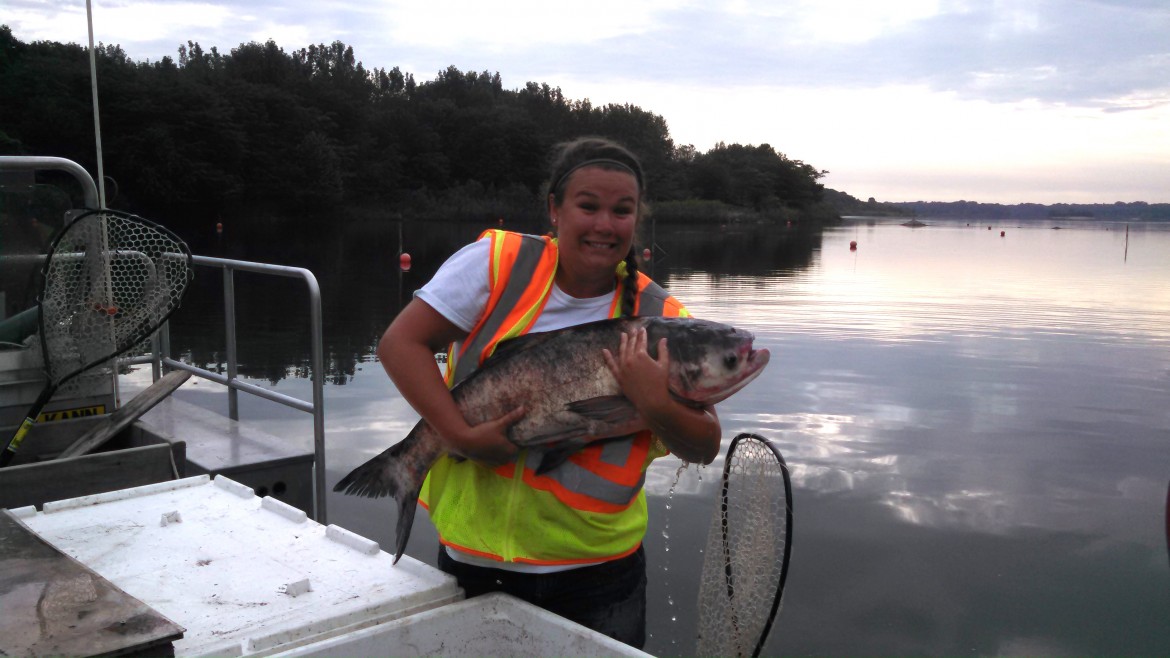
Researcher Kelsie Murchy with a bighead carp that might be repelled by sound. Image: Brooke Vetter
By Morgan Linn
Sound could be the answer to keeping invasive silver carp out of the Great Lakes.
A recent study found that it’s a certain kind of sound that could be the key to scaring off unwanted fish.
It’s not just any sound. What appears to be most effective is complex sound that consists of multiple pure tones. Pure tones are individual frequencies. An example is a dial tone. Complex sound is more like white noise, said Allen Mensinger, coauthor of the study and a biology professor at the University of Minnesota Duluth.
Here is a sample of one of the sound files researchers used. (Warning: low volume is advised)
Humans can hear the sound from a boat, but it is muffled from being underwater, Mensinger said.
Previous studies show that pure tones work to a certain extent, but complex sound is more effective, the study reported. It would be even more successful if combined with other deterrence methods, according to Mensinger and his collaborators at the U.S. Geological Survey’s Upper Midwest Environmental Sciences Center.
They found that complex sound deters 90 to 95 percent of the fish. Very few carp would get past it, Mensinger said. If used in a series of locks and dams, the number of fish getting through would drop at each dam, keeping the population at a very low level.
The carp dominate large areas of the Mississippi River and are making their way toward the Great Lakes.
They are increasingly found in shipping canals connecting Lake Michigan and the Illinois River, said Matthew Diana, a fisheries aquatic research biologist for the Illinois Natural History Survey. The greatest risk is if the fish cross the lakes and enter rivers that could sustain them.
The carp are harmful due to their “fast growth, prolific spawning, and ability to outcompete native fish for food and space,” the researchers reported. These important native fish include paddlefish, gizzard shad and bigmouth buffalo.
“The concern is that they would get into the system and deplete the prey resources that other native fish use, or other sports fish that are important to the Great Lakes ecosystem,” Diana said.
In addition, silver carp threaten boaters and anglers. They are easily startled by loud noises, which cause them to leap out of the water, sometimes knocking out boaters, breaking noses and cracking windshields, according to the University of Wisconsin Sea Grant Institute.
Researchers have tried deterring the fish with mixed results. They’ve used bubble barriers, strobe lights, pure tones and pressure guns.
These methods have been demonstrated, but using them in a river is a problem because of environmental or regulatory concerns, Diana said. Electric barriers are used at the front of the potential invasion and are one of the more effective options.
“Considerable effort has gone into erecting electric barriers on the Chicago Ship and Sanitary Canal to prevent spread into Lake Michigan,” Diana said.
But there are inherent risks. “The electric barriers have lots of problems: they can kill people, they are very expensive, they are hard to maintain,” Mensinger said.
Complex sound could be ideal for stopping the carp, without the risks of an electrical barrier. The equipment is portable, it’s very inexpensive and it could even be run on a car battery in case of a power outage, Mensinger said.

Researcher Brooke Vetter in front of the tanks used to hold carp for sound study. Image: Brooke Vetter
Sound could also be especially useful in areas where physical barriers are not feasible, Diana said.
One concern is that it could also deter native game fish. But the researchers found that the complex sound only bothers the silver and bighead carp, another invasive Asian carp species.
The reason is that the carp are a type of fish — called ostariophysan – with “a specialized connection between their swim bladder and their inner ear, so they can hear higher frequency sounds,” Mensinger said.
While the carp are deterred by the sounds, the game fish can’t hear the noise. “The sound that we’re using drives the silver and bighead carp insane,” Mensinger said. “We’re not saying that all native fish can’t hear this sound, but the majority of the game fish, the fish that people are really interested in from a recreational point of view, would not be affected.”
More research is being conducted to determine what other fish could be impacted.
The researchers have moved on from small tanks and are starting to test sound in larger ponds, Mensinger said. This will allow them to adjust the equipment to make it even more effective.
Several groups including the U.S. Army Corps of Engineers, have expressed interest in using the method.
“It is certainly possible that 2016 could see some deployments,” Mensinger. “I’m happy to share the technology with anyone.”
That sounds like a skill saw cutting plywood
So, the sound does not affect game fish,…. what about affecting amphibians, mosquito larvae, or blue-green algae?
The sound reminds me of a jet passing low overhead seconds before it touches down. Nice add to the article.
Gary Wilson